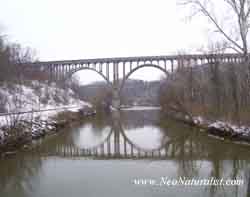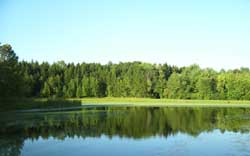Cuyahoga Valley National Park
Towering forests, meandering trails, historic houses, pastoral farmsteads, and a transportation network spanning into pre-historic times. You will find all of these and more when you visit Cuyahoga Valley national Park.
The park, encompassing 33,000 acres between Cleveland and Akron, Ohio, sits astride 22 miles of the Cuyahoga River. With over 125 miles of trails, historic visitor centers, and hundreds of points of interest, this national park is a surefire destination for those of you looking for an affordable family vacation.

The Route 82 bridge crossing the Cuyahoga River within Cuyahoga Valley National Park.
How to get to Cuyahoga Valley National Park
Situated in northeast Ohio, Cuyahoga Valley National Park is easily accessed from the Ohio Turnpike, Interstate 480, Interstate 271, Interstate 77, and State Route 8. Signage at highway exits points the way.
Visitor Centers and Picnic Areas at Cuyahoga Valley National Park
Cuyahoga Valley National Park has five visitor centers to orient you to the park and interpret the significant natural and cultural heritage of the Cuyahoga Valley.
Boston Store Visitor Center is located in the historic hamlet of Boston, on Boston Mills Road, just east of Riverview Road. In addition to telling the story of canal boat building, the visitor center is situated next to a restored Pure Gasoline Station.
Hunt Farm Visitor Center on Bolanz Road south of Peninsula, Ohio, is a small restored house sitting next to the popular Ohio and Erie Canal Towpath Trail. Hunt Farm highlights the agricultural history of the Cuyahoga Valley Area.
Frazee House Visitor Center is open on weekends during the summer. The house sits on Canal Road, south of Rockside Road in Valley View Ohio. Interpreting architectural features, the house includes several cut away sections that provide insights into construction methods used in the 19th century.
Canal Visitor Center, located at the intersection of the Ohio and Erie Canal and Hillside Road, just west of Canal Road in Valley View, Ohio, is a restored canal-era building. The center interprets canal history, and provides periodic demonstrations of a working canal lock.
Peninsula Depot Visitor Center is located in downtown Peninsula on Mill Street, just off Akron Peninsula Road. This small visitor center orients the visitor to the Cuyahoga Valley National Park, and serves as a point of departure for the Cuyahoga Valley Scenic Railroad as well.
For more detailed information and hours, please visit the National Park Service's web site about Cuyahoga Valley's visitor centers.
In addition to the visitor centers, there are opportunities for picnicking around the park. While there are many areas with picnic tables, including most trailheads, here are a few good places to take the family for an informal, relaxing picnic.
Maplewood Picnic Area is a small picnic area located on Akron-Peninsula Road just south of Northampton Road.
Valley Picnic Area is located on Riverview Road south of Peninsula and north of the hamlet of Everett. The Oak Hill area trails are accessible from Valley Picnic Area as well.
Columbia Run Picnic Area is located just south of the intersection of Riverview Road and Columbia Road. The picnic area is near a small meadow, and the small stream for which the picnic area is named.
Oak Hill Day Use Area is accessible from Oak Hill Road, south of Peninsula. In addition to picnic tables, an extensive trail system provides opportunities for exploration. Several fishing ponds dot the landscape along the Oak Hill trails.
The Octagon and Ledges Shelters are located on Truxell Road in the Virginia Kendall unit of Cuyahoga Valley National Park. These structures are significant buildings constructed by the Civilian Conservation Corps during the great depression. Build of local stone and chestnut, these shelters are a rustic reminder of our nation's past, as well as a wonderful place to pass an afternoon with family and friends.

Horseshow Pond, a small man-made pond at Cuyahoga Valley National Park.
Ecological Information about Cuyahoga Valley National Park
Located in the glaciated Allegheny plateau region of northeast Ohio, Cuyahoga Valley National Park is home to a great diversity of plant and animal life. When the last glaciers retreated over 12,000 years ago, they left a patchwork of unstable soils, impenetrable clays, and mixtures of sand and gravel in varying degrees around the area. Upon these soils, and in the valleys and ravines carved through them over the last millennia, a variety of plant communities have been formed.
Most of the valley was cleared for agriculture from the early 1800's. In the 1900's, as farms were abandoned for city life, formerly cleared areas reverted to forest. These second growth forests now cover most of the park.
In the bottomland areas along the river, it is common to see assemblages of trees such as cottonwood, ash and elm growing together. In these bottomland forests, stinging nettles, wingstem, ostrich ferns, and the invasive plant, garlic mustard are the most common plants on the forest floor.
The upland forests of Cuyahoga Valley National Park are varied and diverse. On dry ridges, black, white and red oaks share space with hickories. On moister aspects, beech maple forests thrive. In special places, like cool ravines, or along the Ritchie Ledges, hemlock-beech-maple stands dominate, with yellow and sweet birch trees thrown in for good measure. Many parts of the park are reminiscent of the mixed mesophytic forests of areas further south. However, these are really just successional assemblages owing to the region's history of disturbance. To form a true beech maple forest takes much longer than these second growth forests have been growing. Over time, more and more of the area will be covered with beech maple forests.
Cultural Features at Cuyahoga Valley National Park
In addition to the wonderful natural features, trails, and visitor centers of the park, you may enjoy learning about the Cultural features of Cuyahoga Valley National Park as well. One such feature is the Everett Covered Bridge, located on Everett Road just west of Riverview Road. This bridge is the only covered bridge in Summit County Ohio.The national park also boasts a rich canal-era heritage, with the Ohio and Erie Canal Towpath Trail being one of the most popular attractions in the park. Old aquaducts, weirs, water control devices, and other remnants of that bygone age dot the landscape. Happy Days Lodge, the Virginia Kendall Shelters, and many other depression-era public works are still the basic and most distinct infrastructure of the park today. These, as well as the restored farming enterprises around the park, are all worth exploring.
Trails of Cuyahoga Valley National Park
Just a small sampling of the 125 miles of trails within Cuyahoga Valley National Park have been reviewed here. Try them. You will not be disappointed.
Boston Run Trail
Buckeye Trail, Pine Lane to Boston Mills
Crosscountry Trail
Ledges Trail
Haskell Run Trail
Ohio and Erie Canal Towpath Trail (CVNP Section)
Tree Farm Trail
Virginia Kendall Lake Trail
